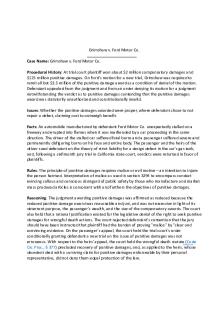Access Now Inc v Southwest Airlines Co case brief PDF

| Title | Access Now Inc v Southwest Airlines Co case brief |
|---|---|
| Author | Adam Teper |
| Course | Legal Framework Business |
| Institution | University of Massachusetts Dartmouth |
| Pages | 2 |
| File Size | 52.9 KB |
| File Type | |
| Total Downloads | 13 |
| Total Views | 134 |
Summary
legal writing - business case briefs...
Description
Access Now Inc., v. Southwest Airlines Co. 227 F. Supp. 2d 1312 United States District Court for the Southern District of Florida Facts:
Robert Gumson, a blind man, tried to use technology in order to navigate through southwest’s website. Due to the way the website was set up, Gumson was unable to use the website using the technology available for blind individuals. Gumson, filed suit along with Access Now, Inc., against Southwest Airlines Co, alleging violations of Title III of the ADA. The suit was filed in Federal District Court. Southwest filed a motion to dismiss based on a failure by the plaintiff to state a claim under Rule 12(b) of the Federal Rules of Civil Procedure. Southwest argued that their website is not a place of public accommodation.
Issues:
Was this suit legitimately stated in the complaint? Does the statute in violation need to be clearly stated within the complaint for the suit to be heard? Was there a notion of public accommodation under first glance? Are virtual websites covered under the laws of the American Disabilities Act?
Rule of Law:
To properly file suit and state a claim to be heard, the Plaintiff must bring the suit under the law that is stated within the complaint. If the statute isn’t stated or cited, the court cannot hear a claim regarding violations of such statute.
Holding:
Trial Court agreed and granted the Motion to Dismiss under Rule 12(b)(6) on the lack of named statute violations in the claim.
Reasoning:
Any claim filed in court must have a statutory basis for the suit to move forward; therefore, the statutory claim needs to be cited and clearly stated in the claim and the violations that arise from the statutes. When looking at Title III of the ADA, it talks about places of Public Accomodation, and the claim cited violations of this in regards to the website. After examination of both the website and the text language of the ADA, there is nothing to hold that a website falls under that basis of protections and therefore, there is no true violations of statutes named in the suit. They also find that under the rules of the ADA needing a physical grounded place, an airplane does not fall under those rules and the airplane would be the website’s closest physical asset.
Analysis/Opinions: This is a case that was careful not to set precedent. No one can reasonably expect that every website created should be readily usable for disabled and blind individuals with forms of technology in which to do so.
The Plaintiff’s also filed a claim that wasn’t properly cited and did not make it clear to the courts exactly what had been violated, as Title III of the ADA did not word their statutes to include websites. This case was a far reach for both Plaintiff’s and they ultimately failed....
Similar Free PDFs

Southwest Airlines Case Analysis
- 6 Pages

Southwest airlines case
- 4 Pages

Southwest airlines case study
- 52 Pages

Southwest Airlines Case Study
- 2 Pages

Case Southwest Airlines
- 2 Pages

Southwest Airlines Report
- 21 Pages

Caso Southwest Airlines
- 2 Pages

Caso Southwest Airlines - cap
- 4 Pages

Southwest Airlines Q\'s
- 2 Pages
Popular Institutions
- Tinajero National High School - Annex
- Politeknik Caltex Riau
- Yokohama City University
- SGT University
- University of Al-Qadisiyah
- Divine Word College of Vigan
- Techniek College Rotterdam
- Universidade de Santiago
- Universiti Teknologi MARA Cawangan Johor Kampus Pasir Gudang
- Poltekkes Kemenkes Yogyakarta
- Baguio City National High School
- Colegio san marcos
- preparatoria uno
- Centro de Bachillerato Tecnológico Industrial y de Servicios No. 107
- Dalian Maritime University
- Quang Trung Secondary School
- Colegio Tecnológico en Informática
- Corporación Regional de Educación Superior
- Grupo CEDVA
- Dar Al Uloom University
- Centro de Estudios Preuniversitarios de la Universidad Nacional de Ingeniería
- 上智大学
- Aakash International School, Nuna Majara
- San Felipe Neri Catholic School
- Kang Chiao International School - New Taipei City
- Misamis Occidental National High School
- Institución Educativa Escuela Normal Juan Ladrilleros
- Kolehiyo ng Pantukan
- Batanes State College
- Instituto Continental
- Sekolah Menengah Kejuruan Kesehatan Kaltara (Tarakan)
- Colegio de La Inmaculada Concepcion - Cebu






